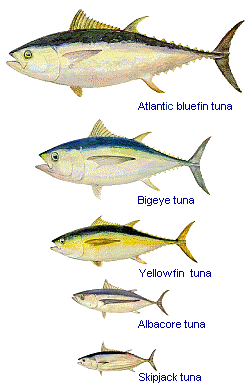Critically endangered: Southern Bluefin (Thunnus maccoyii).
Endangered: Atlantic Bluefin (T. thynnus).
Vulnerable: Bigeye (T. obesus)
Near threatened: Yellowfin (T. albacares), Albacore (T. alalunga).

Figure 1: Size comparison chart of some tuna species. The Atlantic bluefin can reach a size of 3m and a weight of 650kg, the Bigeye tops at 2.3m and 200kg, the Yellowfin reaches 2m and 175kg, the Albacore 1.27m and 40kg, and the Skipjack 1.08m and 33kg. These numbers are maximal values. (Not mentioned on the figure, but for comparison, the Southern Bluefin reaches 2.25m and 160kg.)
(Source: Food and Agriculture Organization)
To make clear what this ranking means, here are the categories on the IUCN Red List:
Extinct or Extinct in the Wild
Critically Endangered, Endangered and Vulnerable: species threatened with global extinction
Near Threatened: species close to the threatened thresholds or that would be threatened without ongoing specific conservation measures
Least Concern: species evaluated with a lower risk of extinction
Data Deficient: no assessment because of insufficient data
Critically Endangered (Possibly Extinct): this is not a new IUCN Red List Category, but is a flag developed to identify those Critically Endangered species that are in all probability already Extinct but for which confirmation is required, for example, through more extensive surveys being carried out and failing to find any individuals.
These tuna species have a rather large economic value and are popular food-items. Sadly, these species are being overfished and many populations of these animals are exploited by multinational fisheries whose regulation has proven quite difficult. The Southern Bluefin population is already considered to be collapsed with little to no hope for recovery.
Recovery for these species will not be easy and will take time, as these species reach maturity fairly late and have a low reproductive turnover. Furthermore, their position at the top of the pelagic food chain might result in negative effects on other species should their populations continue to decline.
The future of these species depends on the ability of fisheries and governments to properly manage their populations. However, the measures needed to achieve durable and stable tuna fishing efforts would likely affect short-term profits, which inhibits the implementation of the needed changes. But if nothing is done, several tuna species are likely to go extinct in the next decades...



Comments